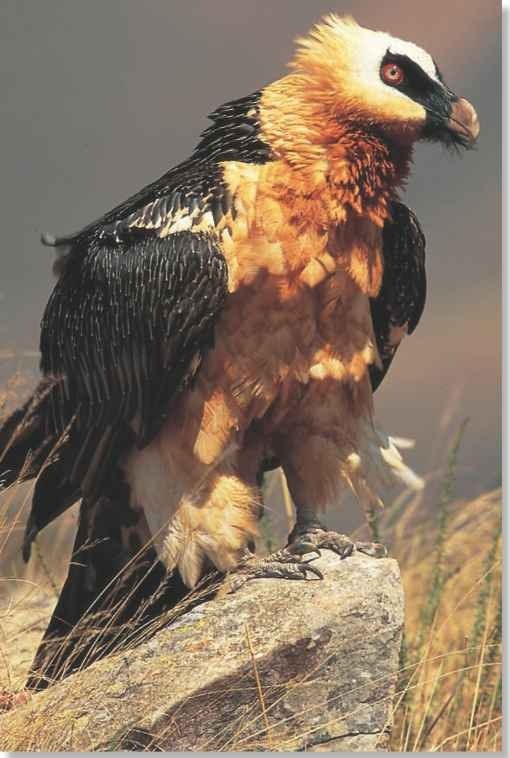ORDER
Falconiform.es
FAMILY
Accipitridae
GENUS & SPECIES
key features
• One of the world’s argest birds of prey, this vulture has bold plumage and an |’ impressive “moustache”
• Magnificent in the air, with a striking flight silhouette and the ability to soar effortlessly for hours on end
• Obtains most of its food by scavenging for carrion and breaking bones to expose the nutritious marrow
where in the world?
Ranges in central and southwest Asia, from Turkey to China and j Mongolia; also found in East and South Africa, the Atlas Mountains of Africa, Corsica, Greece, the Pyrenees and the Arabian Peninsula

LIFECYCLE
The lammergeier is a scarce but legendary hunter and scavenger, renowned not just for its majesty in the air, but also for its spectacular use of gravity to break open bones.
HABITAT
The lammergeier favors wild, rugged mountainscape altitudes of 3,300-9,900′, but it’s sometimes found on peaks, up to 14,850′ that are free of permanent ice. Its common haunts are crags and steep ridges where there are flat, level rocks that can be used as bone-breaking platforms.The lammergeier also occurs in lowland wilderness, including open steppes and tropical plains, exploiting thermals that rise over the latter.
The lammergeier is scarce in Europe, where it is confined to the most remote sites.
Riding the thermals The lammergeier lives in South Africa’s Drakensberg Mountain.

Tell tail
In flight, the lammergeier’s tail appears as a distinctive, elongate wedge.
Owing to its prominent beardlike bristles that grow forward along the bill, the lammergeier is sometimes referred to as the “bearded vulture.”
In parts of Asia the lammergeier may visit rural settlements on ritual slaughter days, hoping to snatch scraps from freshly butchered carcasses.
CONSERVATION
The lammergeier is extinct in many areas due to hunting and poisoning. Since 1986 a conservation program has reintroduced 60 birds to the Alps of France, Switzerland, Austria and Italy.

A Eye in the sky The lammergeier soars high over its range on thermals and updrafts.
Although a lone hunter, a pair of lammergeirs occupies and carries out most of its feeding in home ranges as large as I 20-sq miles. Within this living space, the pair typically uses up to five different roost sites and maintains several alternative eyries, used in rotation from one nesting season to the next.
With apparent ease, a lammergeier may fly over 24 miles in one day while hunting. After a few heavy downstrokes to lift itself from its perch, the bird sets off with its great wings held straight, soaring upward on warm thermals with barely a wingbeat, or gliding parallel to the ground with an occasional flap. At times the lammergeier flies to great heights, but it also spends more time than most vultures in the lower airspace, a few yards from the ground.
To descend, the bird spreads and angles back its wings— rather like a falcon —then glides or swoops, pulling up at the last moment to settle gracefully.
The lammergeier perches with its body held in a more oblique posture than do most vultures, with its head held up and the wingtips free of the tail. Its powerful legs enable it to walk over ground with ease.
FOOD & HUNTING
The lammergeier is primarily a scavenger Despite its size, it usually waits until other raptors, such as vultures, have had their fill before visiting a carcass. It bites clean through small bones, or holds them in its bill and bashes them against rocks.
To extract the marrow from larger bones, this bird repeatedly drops them onto an “ossuary,” an outcrop of flat rock. It does the same to crack tortoise shells. Occasionally it attacks sickly goats on rocky slopes, dislodging them by furiously flapping its wings.
BONE-BREAKER WITH PATIENCE

A Cleaning up the scraps
The lammergeier eats bones as long as 4″ without breaking them. Digestion begins on the bone end in the stomach while the other end is still in the bird’s bill.
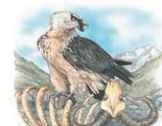
A deserted carcass…
The lammergeier returns to a carcass after other scavengers have fed on it; it specializes in hacking into tough skin and bones.
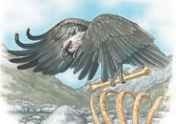
With no meat left…
Grasping a heavy leg bone in its talons, the lammergeier flies to one of its bone-breaking sites. It climbs to a height of 165-264′.
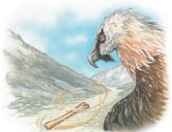
But I’ll settle for bones…
As it approaches the spot, the bird dips slightly to increase momentum; it drops the bone, then turns abruptly and follows it down.
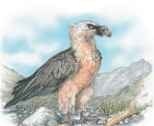
If I can break them
Up to 50 drops may be needed before the bone breaks on the rock. Further blows against the hard ground expose the marrow.
BREEDING
Breeding lammergeier pairs stay together for life. Up to three months before breeding, the pair re-establishes their nest site in a niche in a cliff. The birds strengthen their pair-bond with exchanges of food, mutual preening and spectacular aerial dances involving spirals, dives, rolls and twists. In one flight display, the birds chase each other before gripping claws and tumbling to within yards of the ground. The pair refurbishes the nest with wool and dry dung before the female lays her clutch of mottled eggs.
Compared with other large raptors,the male lammergeier plays a major part in caring for the young. Both sexes take turns incubating the clutch and feeding the nestlings; they continue to bring food morsels for a few weeks after the chicks have their flight feathers.

A Bloodline
The adult lammergeier brings food back to the nest for its partner and hungry fledglings.
PROFILE
Lammergeier
Massively built, the lammergeier has the long and slender wings of a glider and the strength to lift heavy bones into the sky.
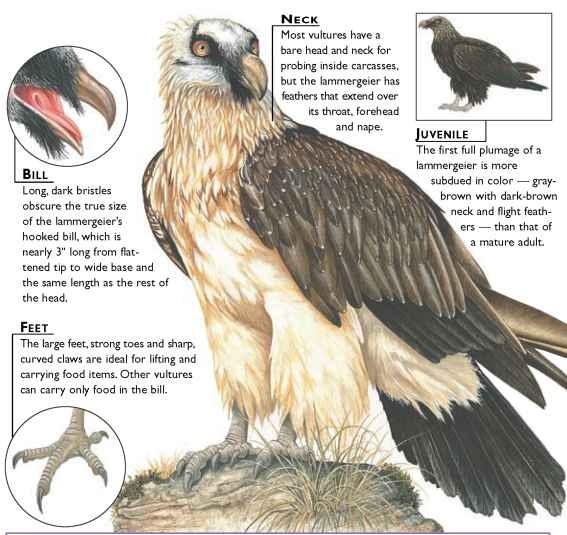
CREATURE COMPARISONS
The bird that most resembes the lammergeier in general shape is the smaller Egyptian vulture (Neophron-percnopterus), which has a similarly broad range. However the Egyptian vulture is-only two-thirds the size of the lammergeier, with a striking whit plumage and a more delicate bill free of bristles. In
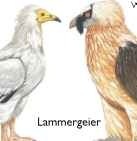
Egyptian vulture
both species the juvenile has dark plumage, but the lammergeier is larger in size with narrower wing points than the Egyptian vulture.
Both are carrion feeders and have been known to use rocks to break open food items. Using its bill, the Egyptian vulture hurls stones against ostrich eggs to get its contents.
| vital | |
| statistics | |
| Weight | 10-15.5 lbs. |
| Length | 3.5-3.8′ |
| Wingspan | 8.75-9.3′ |
| Sexual Maturity | 5 years |
| Breeding -:Season | Varies according to region; January-July in southern Europe |
| Number of Eggs | Usually 1 or 2, occasionally 3 |
| Incubation Period | 55-60 days |
| Fledging Period | 100-110 days |
| Breeding Interval | 1 year |
| Typical Diet | Hunts small mammals and birds; carrion |
| Lifespan | Unknown |
Related species
Birds of prey form a large order, Falconiformes, of 5 families. Accipitridae, the biggest family, includes hawks, buzzards, kites, -harriers, eagles and Old World vultures. The lammergeier is sole member of its genus, but the family has 13 other vulture species with 8 genera. The 7 species of New World vulture form a separate family, Cathartidae, and are not related to their Old World counterparts.
